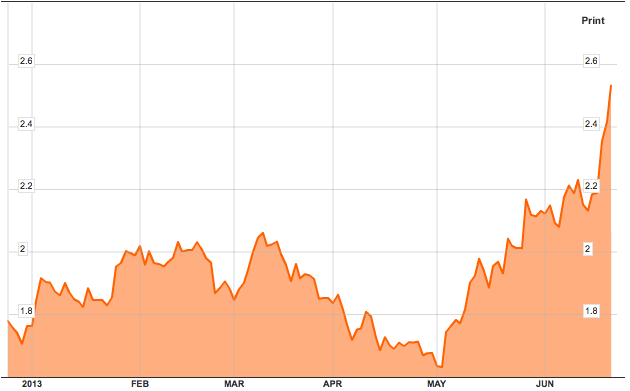According to the share price index future contract, the Australian stock market faces a rough morning when trading restarts after the weekend break.
The ASX 200 index was down 33 points to 4655 in offshore trading early Saturday, indicating a fall of around half a percent or so this morning after it closed at 4738.8 on Friday afternoon in Australia (down 0.4% after a 1.4% slump in early trading).
The Aussie dollar also ended weaker in New York, finishing at 92.20 on Saturday morning, a fall from the 95.42c level before the Fed announcements early Thursday morning, our time.
The currency is now down around 13% from its highs in mid-May (just before the comments from Fed chairman, Ben Bernanke which triggered the initial sell-off in bonds, currencies and shares).
Gold stocks though might get some relief from a small rise in the value of the metal in New York (around $US12 to just under $US1300 an ounce – down $US500 an ounce from its 52 week thigh of $US1804.
But the fall in the Aussie dollar’s value has been nowhere near enough to soften the blow to the sector from the sell-off since April.
Taking into account Friday’s close, our market lost 1.1% last week to be just 1.9% ahead from the start of the year, with some major miners such as BHP Billiton and Rio Tinto firming in afternoon trading, despite fears about the health of the Chinese economy.
In contrast, the Standard & Poor’s 500 index fell 2.1% last week (so our market outperformed Wall Street), but remains 11.7% ahead for the year so far.
From their mid May highs Japanese shares have had falls of 20% and Eurozone shares -8%. Australian shares are down more than 10%.
Global shares in aggregate have corrected by around 7%, so the Australian markets had under performed badly.
That all points to investors’ belief that the prospects for the US economy are stronger than the Australian market.
That in turn was reflected in the statements from Fed chairman Ben Bernanke last week and the more optimistic forecasts about the immediate outlook for the US economy (but not unemployment which remains weak).
We will get some further reminder this week that the US economy is doing OK, with data on house prices, home sales (perhaps the key growth part of the economy), consumer confidence and prices and spending.
China’s weakness and the crack down on banking lending is an extra factor for Australia.
China’s central bank took the pressure off interbank rates on Friday with a cash injection to boost liquidity.
Interest rates fell and the prospects of a credit crunch have eased for the time being. But surveys of Chinese businesses, consumers and investors point to weakening sentiment about the outlook in China in the months ahead.
The AMP and several other experienced China watchers think there’s a good chance growth in the current quarter (ending next Sunday) could dip under 7.5% and end up closer to 7% because of the sluggish level of activity in manufacturing.
But the US has better growth prospects – that’s what the relative outperformance of the S&P 500 and US bond yields are telling us.
The US yields on 10 year bonds hit 2.53% on Friday night, our time, the highest for over a year.
US 10Y YTD – US bond yields telling us America is on the improve

That reflects the improvement in the economy (helped by last week’s optimism from the Fed) and not a credit crunch in China.
But it could have a similar fallout in some sectors with mortgage rates rising. It also appears to be an attempt to prick a perceived investment bubble in some markets (junk bonds and emerging market bonds).
The AMP’s Dr Shane Oliver said at the weekend that while "it’s too early to say that the falls in shares are over, however we remain of the view that it’s just a correction and that the broad cyclical trend remains up.
"Shares are far from expensive, monetary conditions are likely to remain very easy with interest rate hikes a long way off and the gradually strengthening global growth outlook points to stronger profits ahead. So by year end we see further upside in global and Australian shares.
"While Australian shares remain vulnerable in the short term as uncertainty about the Australian economic outlook continues they are expected to benefit by year end from low interest rates boosting high yield stocks and the combination of lower interest rates and a lower $A driving improved profit expectations.
"While bond yields have moved up too far too fast lately given the outlook for short term interest rates, sovereign bonds are fundamentally vulnerable as improving global growth will likely see yields trend higher," Dr Oliver wrote.
While we balance for the half year and full year, many American companies are preparing for the end of their second quarter.
Given the Fed’s pronouncements and the flow of economic data, corporate results should be good this quarter.
But so far the early signs are for a slow and weak quarter on the whole. Thomson Reuters said last week that forecast earnings growth for the quarter has fallen to just 3.2% from 6.1% at the start of April.
Earnings warnings are running ahead of upgrades at the rate of 6.5 to one, according to Thomson Reuters, with consumer-facing and technology companies reporting the most downgrades and fewer upgrades.













